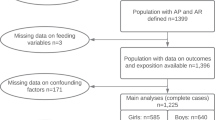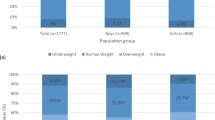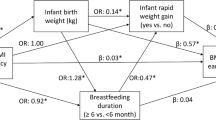Abstract
Background/objectives
The role of infant feeding practices in longitudinal growth trajectories in children remains equivocal. This study utilised two longitudinal approaches to examine the associations of infant feeding mode (breastfeeding, mixed feeding, formula feeding), breastfeeding duration, and the timing of solid foods introduction with body mass index (BMI) z-score in early childhood.
Subjects/methods
Secondary analyses of data from the Healthy Beginnings Trial were conducted. Infant feeding practices were reported by mothers at 6, 12, and 24 months of child age. Child weight and length were measured at birth, 12, 24, 42, and 60 months. Two longitudinal approaches: linear spline multilevel model (LSMM) and group-based trajectory modelling (GBTM) were used to describe BMI z-score trajectories and assess its associations with infant feeding practices.
Results
The LSMM approach demonstrated that the breastfeeding group showed lower BMI z-scores from ages 12 to 60 months than the mixed feeding and formula feeding groups. Children who were breastfed for ≥ 6 versus < 6 months exhibited a lower BMI z-score trajectory from ages 12 to 60 months. Results from the GBTM approach revealed that the mixed feeding (OR: 1.83, 95%CI 1.04, 3.21) and the formula feeding group (OR: 2.00, 95%CI 0.67, 5.92) showed a tendency for higher odds of following the “High BMIz” trajectory than the breastfeeding group. Breastfeeding duration ≥6 versus < 6 months was linked with lower odds of following the “High BMIz” trajectory (OR 0.65, 95%CI 0.43, 0.98). Both approaches revealed no evidence of an association between the timing of solid foods introduction and BMI z-score trajectory.
Conclusions
The two longitudinal approaches revealed similar findings that infant feeding mode and breastfeeding duration, but not the timing of solid foods introduction, were associated with BMI z-score trajectory in early childhood. The findings provide robust longitudinal evidence to encourage and support extended breastfeeding for childhood obesity prevention.
This is a preview of subscription content, access via your institution
Access options
Subscribe to this journal
Receive 12 print issues and online access
$259.00 per year
only $21.58 per issue
Buy this article
- Purchase on Springer Link
- Instant access to full article PDF
Prices may be subject to local taxes which are calculated during checkout



Similar content being viewed by others
References
World Health Organization. Obesity and overweight. In, 2020. https://www.who.int/news-room/fact-sheets/detail/obesity-and-overweight.
Simmonds M, Llewellyn A, Owen CG, Woolacott N. Predicting adult obesity from childhood obesity: a systematic review and meta-analysis. Obes Rev. 2016;17:95–107.
Dietz WH. Health consequences of obesity in youth: childhood predictors of adult disease. Pediatrics. 1998;101:518–25.
Hardy LR, Harrell JS, Bell RA. Overweight in children: definitions, measurements, confounding factors, and health consequences. J Pediatr Nurs. 2004;19:376–84.
Rundle AG, Factor-Litvak P, Suglia SF, Susser ES, Kezios KL, Lovasi GS, et al. Tracking of obesity in childhood into adulthood: effects on body mass index and fat mass index at age 50. Child Obes. 2020;16:226–33.
Lanigan J, Singhal A. Early nutrition and long-term health: a practical approach. Proc Nutr Soc. 2009;68:422–9.
Koletzko B, Brands B, Grote V, Kirchberg FF, Prell C, Rzehak P, et al. Long-term health impact of early nutrition: the power of programming. Anna Nutr Metab. 2017;70:161–9.
Dieterich CM, Felice JP, O’Sullivan E, Rasmussen KM. Breastfeeding and health outcomes for the mother-infant dyad. Pediatr Clin North Am. 2013;60:31–48.
Qiao J, Dai LJ, Zhang Q, Ouyang YQ. A meta-analysis of the association between breastfeeding and early childhood obesity. J Pediatr Nurs. 2020;53:57–66.
Marseglia L, Manti S, D’Angelo G, Cuppari C, Salpietro V, Filippelli M, et al. Obesity and breastfeeding: the strength of association. Women Birth: J Australian College Midwives. 2015;28:81–6.
Ventura AK. Developmental trajectories of bottle-feeding during infancy and their association with weight gain. J Dev Behav Pediatr. 2017;38:109–19.
World Health Organization. Global strategy on infant and young child feeding In. Geneva: World Health Organization, 2003.
NHMRC (National Health and Medical Research Council). Infant Feeding Guidelines: Summary. In: National Health and Medical Research Council, (ed). Canberra, 2013.
Section on B. Breastfeeding and the use of human milk. Pediatrics. 2012;129:e827–41.
Gale C, Logan KM, Santhakumaran S, Parkinson JR, Hyde MJ, Modi N. Effect of breastfeeding compared with formula feeding on infant body composition: a systematic review and meta-analysis. Am j Clin Nutr. 2012;95:656–69.
Giugliani ERJ. Growth in exclusively breastfed infants. J Pediatr. 2019;95:79–84.
Iguacel I, Monje L, Cabero MJ, Moreno Aznar LA, Samper MP, Rodriguez-Palmero M, et al. Feeding patterns and growth trajectories in breast-fed and formula-fed infants during the introduction of complementary food. Nutr Hosp. 2019;36:777–85.
Arenz S, Ruckerl R, Koletzko B, von Kries R. Breast-feeding and childhood obesity-a systematic review. Inter J Obes Relat Metab Disord. 2004;28:1247–56.
Jwa SC, Fujiwara T, Kondo N. Latent protective effects of breastfeeding on late childhood overweight and obesity: a nationwide prospective study. Obesity. 2014;22:1527–37.
Cheng TS, Kwok MK, Leung GM, Schooling CM. The associations of breast feeding with infant growth and body mass index to 16 years: ‘children of 1997’. Paediatr Perinat Epidemiol. 2018;32:200–9.
Patel N, Dalrymple KV, Briley AL, Pasupathy D, Seed PT, Flynn AC, et al. Mode of infant feeding, eating behaviour and anthropometry in infants at 6-months of age born to obese women - a secondary analysis of the UPBEAT trial. BMC Pregnancy Childbirth. 2018;18:355.
Garden FL, Marks GB, Simpson JM, Webb KL. Body mass index (BMI) trajectories from birth to 11.5 years: relation to early life food intake. Nutrients. 2012;4:1382–98.
Buyken AE, Karaolis-Danckert N, Remer T, Bolzenius K, Landsberg B, Kroke A. Effects of breastfeeding on trajectories of body fat and BMI throughout childhood. Obesity. 2008;16:389–95.
Eny KM, Chen S, Anderson LN, Chen Y, Lebovic G, Pullenayegum E, et al. Breastfeeding duration, maternal body mass index, and birth weight are associated with differences in body mass index growth trajectories in early childhood. Am J Clin Nutr. 2018;107:584–92.
Wen LM, Baur LA, Rissel C, Flood V, Simpson JM, Hayes A, et al. Healthy beginnings trial phase 2 study: follow-up and cost-effectiveness analysis. Contemp Clin Trials. 2012;33:396–401.
Wen LM, Baur LA, Rissel C, Wardle K, Alperstein G, Simpson JM. Early intervention of multiple home visits to prevent childhood obesity in a disadvantaged population: a home-based randomised controlled trial (healthy beginnings trial). BMC Public Health. 2007;7:76.
Wen LM, Baur LA, Simpson JM, Rissel C, Flood VM. Effectiveness of an early intervention on infant feeding practices and “tummy time”: a randomized controlled trial. Arch Pediatr Adolesc Med. 2011;165:701–7.
Wen LM, Baur LA, Simpson JM, Rissel C, Wardle K, Flood VM. Effectiveness of home based early intervention on children’s BMI at age 2: randomised controlled trial. BMJ. 2012;344:e3732.
Wen LM, Baur LA, Simpson JM, Xu H, Hayes AJ, Hardy LL, et al. Sustainability of effects of an early childhood obesity prevention trial over time: a further 3-year follow-up of the healthy beginnings trial. JAMA Pediatr. 2015;169:543–51.
Hector D, Webb K, Lymer S. Describing breastfeeding practices in New South Wales using data from the NSW child health survey, 2001. NSW Public Health Bull. 2005;16:47–51.
Wen LM, Baur LA, Rissel C, Xu H, Simpson JM. Correlates of body mass index and overweight and obesity of children aged 2 years: findings from the healthy beginnings trial. Obesity. 2014;22:1723–30.
Zheng M, Cameron AJ, Birken CS, Keown-Stoneman C, Laws R, Wen LM, et al. Early infant feeding and BMI trajectories in the first 5 years of life. Obesity. 2020;28:339–46.
WHO Multicentre Growth Reference Study Group. WHO Child Growth Standards: Length/height-for-age, weight-for-age, weight-for-length, weight-for-height and body mass index-for-age: Methods and development. In. Geneva: World Health Organization, 2006.
Cole TJ, Lobstein T. Extended international (IOTF) body mass index cut-offs for thinness, overweight and obesity. Pediatr Obes. 2012;7:284–94.
StataCorp. Stata Statistical Software: Release 15, TX: StataCorp LLC College Station, 2017.
Howe LD, Tilling K, Matijasevich A, Petherick ES, Santos AC, Fairley L et al. Linear spline multilevel models for summarising childhood growth trajectories: A guide to their application using examples from five birth cohorts. Stat Methods Med Res. 2016;25:1854-1874.
Tilling K, Macdonald-Wallis C, Lawlor DA, Hughes RA, Howe LD. Modelling childhood growth using fractional polynomials and linear splines. Anna Nutr Metab. 2014;65:129–38.
Nagin DS. Group-based trajectory modeling: an overview. Anna Nutr Metab. 2014;65:205–10.
Nagin DS. Group-Based Modeling of Development. Harvard University Press, 2005.
Bell KA, Wagner CL, Feldman HA, Shypailo RJ, Belfort MB. Associations of infant feeding with trajectories of body composition and growth. Am J Clin Nutr. 2017;106:491–8.
Carling SJ, Demment MM, Kjolhede CL, Olson CM. Breastfeeding duration and weight gain trajectory in infancy. Pediatrics. 2015;135:111–9.
Chivers P, Hands B, Parker H, Bulsara M, Beilin LJ, Kendall GE, et al. Body mass index, adiposity rebound and early feeding in a longitudinal cohort (Raine Study). Int Journal Obes. 2010;34:1169–76.
Liu JX, Liu JH, Frongillo EA, Boghossian NS, Cai B, Hazlett LJ. Body mass index trajectories during infancy and pediatric obesity at 6 years. Anna Epidemiol. 2017;27:708–715.e1.
Rzehak P, Oddy WH, Mearin ML, Grote V, Mori TA, Szajewska H, et al. Infant feeding and growth trajectory patterns in childhood and body composition in young adulthood. Am J Clin Nutr. 2017;106:568–80.
Oddy WH, Mori TA, Huang RC, Marsh JA, Pennell CE, Chivers PT, et al. Early infant feeding and adiposity risk: from infancy to adulthood. Ann Nutr Metab. 2014;64:262–70.
Zheng M, Lamb KE, Grimes C, Laws R, Bolton K, Ong KK, et al. Rapid weight gain during infancy and subsequent adiposity: a systematic review and meta-analysis of evidence. Obes Rev. 2018;19:321–32.
Ong KK, Loos RJ. Rapid infancy weight gain and subsequent obesity: systematic reviews and hopeful suggestions. Acta paediatrica. 2006;95:904–8.
Vasquez-Garibay E, Larrosa-Haro A, Guzman-Mercado E, Munoz-Esparza N, Garcia-Arellano S, Munoz-Valle F, et al. Appetite-regulating hormones and anthropometric indicators of infants according to the type of feeding. Food Sci Nutr. 2020;8:993–1000.
Tang M. Protein intake during the first two years of life and its association with growth and risk of overweight. Int J Environ Res Public Health. 2018;15:1742.
Davies M. Commentary: early lessons in life: maternal education and fetal growth. Int J Epidemiol. 2010;39:1261–3.
van Ansem WJ, Schrijvers CT, Rodenburg G, van de Mheen D. Maternal educational level and children’s healthy eating behaviour: role of the home food environment (cross-sectional results from the INPACT study). International J Behav Nutr Phys Act. 2014;11:113.
Liu J, Liu J, Frongillo EA Jr., Boghossian NS, Cai B, Zhou H, et al. Body mass index trajectories during the first year of life and their determining factors. Am J Human Biol. 2019;31:e23188.
Moorcroft KE, Marshall JL, McCormick FM. Association between timing of introducing solid foods and obesity in infancy and childhood: a systematic review. Maternal Child Nutr. 2011;7:3–26.
Daniels L, Mallan KM, Fildes A, Wilson J. The timing of solid introduction in an ‘obesogenic’ environment: a narrative review of the evidence and methodological issues. Aus N Z J public health. 2015;39:366–73.
Australian Institute of Health and Welfare. 2010 Australian national infant feeding survey: indicator results. In. Canberra: AIHW, 2011.
Acknowledgements
We acknowledge the contribution of the parents and children who participated in the Healthy Beginnings Trial.
Author information
Authors and Affiliations
Corresponding author
Ethics declarations
Competing interests
The authors declare no competing interests.
Additional information
Publisher’s note Springer Nature remains neutral with regard to jurisdictional claims in published maps and institutional affiliations.
Supplementary information
Rights and permissions
About this article
Cite this article
Zheng, M., Campbell, K.J., Baur, L. et al. Infant feeding and growth trajectories in early childhood: the application and comparison of two longitudinal modelling approaches. Int J Obes 45, 2230–2237 (2021). https://doi.org/10.1038/s41366-021-00892-5
Received:
Revised:
Accepted:
Published:
Issue Date:
DOI: https://doi.org/10.1038/s41366-021-00892-5
This article is cited by
-
Describing the longitudinal breakfast quality index trajectories in early childhood: results from Melbourne InFANT program
European Journal of Clinical Nutrition (2023)
-
Understanding the pathways between prenatal and postnatal factors and overweight outcomes in early childhood: a pooled analysis of seven cohorts
International Journal of Obesity (2023)



